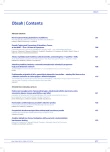The Problematic of Original and Generic Drugs and Biosimilars – Switching of Drugs Today and Tomorrow with the Main Targeting on Biotechnologies- Associated Risks
Authors:
T. Svoboda
Authors‘ workplace:
KOC FN Plzeň
Published in:
Klin Onkol 2010; 23(6): 416-420
Category:
Reviews
Overview
Cheaper drug forms have been administered more and more in the last decade in oncology and in other fields of clinical medicine, too. Their production was enabled by the end of patent protection of the original drugs used previously. The efficacy and reliability of generic drugs and primarily medicaments produced by biotechnology - so- called biosimilars – is the most important question today. There are still some unresolved problems associated with their administration. The current knowledge concerning the safety of biosimilars and possible risks associated with their use is summarised in this review.
Key words:
original drugs – generics – biosimilars – biotechnology – pharmacokinetics – pharmacodynamics – immunogenicity
Sources
1. Bonadonna G, Moliterni A, Zambetti M et al. 30 years‘ follow up of randomised studies of adjuvant CMF in operable breast cancer: cohort study. BMJ 2005; 330(7485): 217– 220.
2. Pettengell R et al. Haematologica 2006; 91 (Suppl 1): 69– 70. Abstract 0185.
3. Chirivella I et al. J Clin Oncol 2006; 24 (part I of II): 44. Abstract 668.
4. Dudzinsky DM, Kesselheim AS. Scientific and Human Viability of Follow‑on Protein Drugs. N Engl J Med 2008; 358(8): 843– 849.
5. Mellstedt H, Niederwasser D, Ludwig H. The challenge of biosimilars. Ann Oncol 2008; 19(3): 411– 419.
6. Locatelli F, Goldsmith D. Biosimilars: uncharted territory. J Nephrol 2007; 20(3): 265– 267.
7. Braun A, Kwee L, Labow MA et al. Protein aggregates seem to play a key role among the parameters influencing the antigenicity of interferon α (IFN- α) in normal and transgenic mice. Pharm Res 1997; 14(10): 1472– 1478.
8. Li S, Schöneich C, Borchardt RT. Chemical instability of protein pharmaceuticals: mechanisms of oxidation and strategies for stabilization. Biotechnol Bioeng 1995; 48(5): 490– 500.
9. Schellekens H. The first biosimilar epoetin: but how similar is it? Clin J Am Soc Nephrol 2008; 3(1): 174– 178.
10. Rosenberg AS. Effects of protein aggregates: an immunologic perspective. AAPS J 2006; 8(3): E501– E507.
11. Jenkins N. Modifications of therapeutic proteins: challenges and prospects. Cytotechnology 2007; 53(1– 3): 121– 125.
12. Locatelli F, Roger S. Comparative testing and pharmacovigilance of biosimilars. Nephrol Dial Transplant 2006; 21 (Suppl 5): v13– v16.
13. Koren E, Zuckerman LA, Mire‑Sluis AR. Immune responses to therapeutic proteins in humans – clinical significance, assessment and prediction. Curr Pharm Biotechnol 2002; 3: 349– 360.
14. Wadhwa M, Thorpe R. Unwanted Immunogenicity: Implications for Follow‑on Biologicals. Drug Inf J 2007; 41: 1– 10.
15. Wadhwa M, Bird C, Dilger P et al. Strategies for detection, measurement and characterization of unwanted antibodies induced by therapeutic biologicals. J Immunol Methods 2003; 278: 1– 17.
16. Singh A. Gaps in the Quality and Potencial Safety of Biosimilar Epoetins in the Developing World: An International Survey, ERA- EDTA, Abst. Nr. 409.
17. Jelkman W. Recombinant EPO production – points the nephrologist should know. Nephrol Dial Transplant 2007; 22(10): 2749– 2753.
18. Koren E, Smith HW, Shores E et al. Recommendations on risk‑based strategie for detection and characterization of antibodies against biotechnology products. J Immunol Methods 2008; 333(1– 2):1– 9.
19. Sharma B. Immunogenicity of therapeutic proteins: Part 2. Impact of container closures. Biotechnol Adv 2007a; 25(3): 318– 324.
20. Sharma B. Immunogenicity of therapeutic proteins: Part 1. Impact of product handling. Biotechnol Adv 2007b; 25(3): 310– 317.
21. Schellekens H. Erythropoietic proteins and antibody- mediated pure red cell aplasia: a potential role for micelles. Nephrol Dial Transplant 2004; 19(9): 2422.
22. Casadevall N, Nataf J, Viron B et al. Pure red- cell aplasia and antierythropoietin antibodies in patients treated with recombinant erythropoietin. N Engl J Med 2002; 346(7): 469– 475.
23. Brockmayer C, Seidl A. Binocrit: assessment of quality, safety and efficacy of biopharmaceuticals. Eur J Hosp Pharm Prac 2009; 15 (2): 34– 40.
24. Covic A, Cannata- Andia J, Cancarini G et al. Biosimilars and Biopharmaceuticals: What the nephrologist need to knot – A positron paper by the ERA- EDTA Council. Nephrol Dial Transplant 2008; 23(12): 3731– 3737.
25. EMEA Committee for Medicinal Products for Human Use. Guideline on similar biological medicinal products containing biotechnology- derived proteins as active substance: non‑clinical and clinical issues. London 2006. Available at: http:/ / www.ema.europa.eu/ docs/ en_GB/ document_library/ Scientific_guideline/ 2009/ 09/ WC500003920.pdf.
26. EMEA Committee for Medicinal Products for Human Use. Guideline on similar biological medicinal products containing biotechnology derived proteins as active substance: quality issues. London, 2006. Available at: http:/ / www.ema.europa.eu/ docs/ en_GB/ document_library/ Scientific_guideline/ 2009/ 09/ WC500003953.pdf.
27. Legifrance.gouvr.fr. Projet de loi portant diverses dispositions d’adaptation au droit communautaire dans le domaine du medicament. Available at: http:/ / www.legifrance.gouv.fr/ html/ actualite/ actualite_legislative/ exp_ddac_medicament.htm.
28. Biosimilar Products. Drug Safety Update 2008; 1(7): 8. Available at http:/ / www.mhra.gov.uk/ mhra/ drugsafetyupdate.
29. Fínek J. Kdy kopie přestává být kopií. Lék list 2009; 2: 34.
30. Mellstedt H et al. Annals of Oncology. Advance Access published on September 14, 2007; doi:10.1093/ annonc/ mdm345.
31. Derleck PJ. Biotherapeutics in the Era of Biosimilars. Chat really matters is patient safety. Drug safety 2007; 30(12); 1087– 1092.
32. European Biopharmaceutical Enterprises. EBE- EFPIA Position paper: inapplicability of automatic substitution rules to biotechnology products, including biosimilar medicinal products: recommendation for addressing unique safety concerns. 31 July 2006. Available at: http:/ / www.ebe- biopharma.org.
33. European Biopharmaceutical Enterprises. EBE- EFPIA Position paper: Naming of biosimilar medicinal products: options for addressing unique safety concerns. 7 July 2006. Available at: http:/ / www.ebe- biopharma.org.
Labels
Paediatric clinical oncology Surgery Clinical oncologyArticle was published in
Clinical Oncology

2010 Issue 6
Most read in this issue
- New Therapeutic Options in Therapy of Glioblastoma Multiforme
- Hormonal Contraceptives and Their Relationship to Breast Cancer
- Acute Myeloblastic Leukaemia with Alternationsof MLL Proto-Oncogene Protein (11q23/ MLL+ AML)
- Postoperative Accelerated Partial Radiotherapy for Breast Cancer
